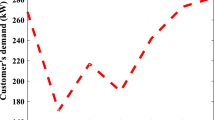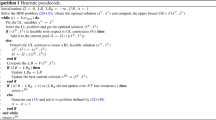Abstract
Players, especially electricity retailers have an important role in achieving optimal economic models in the electricity market. They act as intermediaries between customers and energy suppliers. In this regard, this study proposed an interactive bi-level model in bilateral electricity contracts from the retailer’s viewpoint. At the first level of this interaction, the retailer maximizes its profit by selecting some customers and determining the length of the bilateral contract with each customer. At the second level, customer cost is minimized based on new interactive parameters that are introduced for maximum interaction. In this regard, the optimal amount of energy sales to each customer is also determined based on the proposed bi-level model. Finally, after linearization and determination of the single-level equivalent of the proposed model, the mixed-integer linear programming (MILP) model will be implemented in GAMS software and solved via the CPLEX solver. The results indicate the effect of the proposed interactive model on maximizing retailer profit and minimizing customer costs in bilateral electricity contracts.
















Similar content being viewed by others
Abbreviations
- \({\text{W}} = \left\{ {1,2, \ldots ,{\text{w}}} \right\}\) :
-
Sets related to wholesalers
- \({\text{C}} = \left\{ {1,2, \ldots ,{\text{c}}} \right\}\) :
-
Sets related to customers
- \({\text{T}} = \left\{ {1,2, \ldots ,24} \right\} \) :
-
Sets related to hours time periods of a day
- \( {\text{P}} = \left\{ {0,1 \ldots ,{\text{p}}} \right\} \) :
-
Sets related to duration of bilateral contract between retailer and customers
- \({\text{C}}^{\prime } \subseteq {\text{C}} \) :
-
A customer subset with whom the retailer has a contract in any situation and supplies their energy needs
- \({\text{D}}_{{\text{c}}} \left( {MW} \right) \) :
-
Amount of demand for customer C in a day
- \( {\text{r}}_{{{\text{ct}}}} \left( \% \right)\) :
-
The rate of consumption for customer C during time period t
- \({\text{V}}_{{\text{c}}} \left( {MW} \right) \) :
-
The capacity of storage for customer C
- \(\delta _{{{\text{cp}}}} \left( \% \right) \) :
-
Discount desired by customer C (per unit of energy) in contract with length P (per contract length)
- \(\beta _{{{\text{cp}}}} \left( \$ \right) \) :
-
The revenue from extending the contract with customer C with length P
- \({\text{h}}_{{\text{c}}} \left( {\frac{\$ }{MWh}} \right) \) :
-
Storage cost for a customer C
- \(\varphi _{{\text{t}}} \left( {\frac{\$ }{MWh}} \right) \) :
-
Energy prices during time period t
- \(\rho _{{{\text{wt}}}} \left( {\frac{\$ }{MWh}} \right) \) :
-
Cost of energy supplied by wholesaler W during time period t
- \({\text{cap}}_{{{\text{wt}}}} \left( {MW} \right) \) :
-
Capacity for wholesaler W during period t
- \( {\text{x}}_{{{\text{wt}}}} \left( {MW} \right)\) :
-
Quantity of supplied energy via wholesaler W during time period t
- \( {\text{s}}_{{{\text{ct}}}} \left( {MW} \right)\) :
-
Sales of energy to customer C during time period t
- \( \upalpha _{{{\text{ct}}}} \left( \% \right)\) :
-
Rate of discount offered to customer C during time period t
- \({\text{y}}_{{{\text{cp}}}} \) :
-
This variable is binary and equals to 1, if retailer has a bilateral contract with customer C for length P, otherwise this variable is 0
- \({\text{I}}_{{{\text{ct}}}} \left( {MW} \right) \) :
-
Customer’s energy storage during time period t
- \( {\text{a}}_{{{\text{ct}}}}\) :
-
This variable is binary and equal to 1, if customer C agrees to obtain additional energy during time period t via discount offered by retailer/otherwise this variable is 0
References
Pilipovic D 2007 Energy risk: Valuing and managing energy derivatives, Chapter 1. 2nd edn. Irwin Professional Publishing, McGraw Hill, Maidenhead
Kaminski V 2004 Managing energy price risk: The new challenges and solutions, Chapter 2. 3rd edn. Risk Books, London
Weron R 2017 Modeling and forecasting electricity loads and prices: A statistical approach, Chapter 3. Wiley, Nashville
Benth J S, Koekebakker S and Benth F E 2008 Stochastic modeling of electricity and related markets. World Scientific Publishing, Singapore, pp 1–35
Shahidehpour M Yamin H and Li Z 2008 Market operations in electric power systems: Forecasting, scheduling, and risk management. New York, NY: Wiley-IEEE Press, pp. 1–30
Deng S and Oren S 2006 Electricity derivatives and risk management. Energy (Oxf.) 31(6): 940–953
Sun B, Wang F, Xie J and Sun X 2021 Electricity retailer trading portfolio optimization considering risk assessment in Chinese electricity market. Electric Power Syst. Res. 190: 106833
Kohansal M and Mohsenian-Rad H 2016 Price-maker economic bidding in two-settlement pool-based markets: The case of time-shiftable loads. IEEE Trans. Power Syst. 31(1): 695–705
Nojavan S, Majidi M and Zare K 2018 Optimal scheduling of heating and power hubs under economic and environment issues in the presence of peak load management. Energy Convers. Manag. 156: 34–44
Kirschen D S 2003 Demand-side view of electricity markets. IEEE Trans. Power Syst. 18(2): 520–527
Gabriel S A, Conejo A J, Plazas M A and Balakrishnan S 2006 Optimal price and quantity determination for retail electric power contracts. IEEE Trans. Power Syst. 21(1): 180–187
Wu T, Li G and Bie Z 2019 Power procurement strategies of retailer considering demand response program. 8th Renewable Power Generation Conference (RPG)
Carrion M, Arroyo J M and Conejo A J 2009 A bilevel stochastic programming approach for retailer futures market trading. IEEE Trans. Power Syst. 24(3): 1446–1456
Hatami A, Seifi H and Sheikh-El-Eslami M K 2011 A stochastic-based decision-making framework for an electricity retailer: Time-of-use pricing and electricity portfolio optimization. IEEE Trans. Power Syst. 26(4): 1808–1816
Herranz R, San Roque A M, Villar J and Campos F A 2012 Optimal demand-side bidding strategies in electricity spot markets. IEEE Trans. Power Syst. 27(3): 1204–1213
Khojasteh M and Jadid S 2015 Decision-making framework for supplying electricity from distributed generation-owning retailers to price-sensitive customers. Util. Policy 37: 1–12
Fang X, Li F, Wei Y and Cui H 2016 Strategic scheduling of energy storage for load serving entities in locational marginal pricing market. IET Gener. Transm. Distrib. 10(5): 1258–1267
Nojavan S and Zare K 2018 Optimal energy pricing for consumers by electricity retailer. Int. J. Electr. Power Energy Syst. 102: 401–412
Nojavan S, Zare K and Mohammadi-Ivatloo B 2017 Robust bidding and offering strategies of electricity retailer under multi-tariff pricing. Energy Econ. 68: 359–372
Nojavan S, Zare K and Mohammadi-Ivatloo B 2017 Risk-based framework for supplying electricity from renewable generation-owning retailers to price-sensitive customers using information gap decision theory. Int. J. Electr. Power Energy Syst. 93: 156–170
Zugno M, Morales J M, Pinson P and Madsen H 2013 A bilevel model for electricity retailers’ participation in a demand response market environment. Energy Econ. 36: 182–197
Wei W, Liu F and Mei S 2015 Offering non-dominated strategies under uncertain market prices. IEEE Trans. Power Syst. 30(5): 2820–2821
Wei W, Liu F and Mei S 2015 Energy pricing and dispatch for smart grid retailers under demand response and market price uncertainty. IEEE Trans. Smart Grid 6(3): 1364–1374
Nojavan S, Mehdinejad M, Zare K and Mohammadi-Ivatloo B 2015 Energy procurement management for electricity retailer using new hybrid approach based on combined BICA–BPSO. Int. J. Electr. Power Energy Syst. 73: 411–419
Feuerriegel S and Neumann D 2014 Measuring the financial impact of demand response for electricity retailers. Energy Policy 65: 359–3680
Ahmadi A, Charwand M and Aghaei J 2013 Risk-constrained optimal strategy for retailer forward contract portfolio. Int. J. Electr. Power Energy Syst. 53: 704–713
Boyd S and Vandenberghe L 2004 Convex optimization, Chapter 3 & 4. Cambridge University Press, Cambridge
Boland N, Dey S S, Kalinowski T, Molinaro M and Rigterink F 2017 Bounding the gap between the McCormick relaxation and the convex hull for bilinear functions. Math. Program 162(1–2): 523–535
Castro P M 2015 Tightening piecewise McCormick relaxations for bilinear problems. Comput. Chem. Eng. 72: 300–311
“CPLEX 12”, Gams.com. [Online]. Available: https://www.gams.com/33/docs/S_CPLEX.html
Author information
Authors and Affiliations
Corresponding author
Rights and permissions
About this article
Cite this article
Apornak, K., Soleymani, S., Faghihi, F. et al. Presenting an economic interaction bi-level model between electricity retailer and customer in bilateral electricity market contract. Sādhanā 47, 89 (2022). https://doi.org/10.1007/s12046-022-01814-5
Received:
Revised:
Accepted:
Published:
DOI: https://doi.org/10.1007/s12046-022-01814-5




